
Passive Houses V.
Operation of an energy-passive house
I. Historical Development
II. Designing Low Energy Buildings
III. Design Rules, Conceptual Approach to Passive House Solutions
IV. Measures to Reduce Energy Demand
V. Operation of a Passive House
VI. Examples of Built Low Energy Houses
The current houses built according to the latest experiences of science and construction technology are significantly different from their predecessors. The buildings are heated with a closed system, most often using gas or electricity as a source of energy, without the need to draw air for combustion from the interior. The houses are very tightly sealed, which minimizes uncontrolled infiltration - the supply of air through gaps at the connections of structures.
However, every household produces moisture - through evaporation from plants, cooking, bathing, etc. If the drainage of this moisture is not resolved, it can lead to mold growth and degradation of the building structure (rotting). The only solution to reduce relative humidity is ventilation, which also ventilates other harmful substances from the interior (CO2, formaldehyde, etc.) and ensures the supply of fresh air to the apartment. In tight buildings, however, it is not possible to rely solely on opening windows - this would mean, for example, that in winter at night it would be necessary to get up every 1.5 hours and thoroughly ventilate the entire room. The implemented ventilation in toilets and kitchens (hoods) also does not serve a significant function - while they do extract air when turned on, they create a vacuum in the apartment after a certain time because the building is tight and there is no path for air to be drawn back into the house. Thus, the fans run idle. Using burst ventilation through windows, besides the possibility of creating a draft, discomfort, and cooling of the structure, we also lose the heat that we ventilate out. One of the possible solutions, which is essential in modern airtight buildings, is the use of a forced ventilation system, preferably with heat recovery, (recovering energy from) waste heat. What comfort does it bring to its user?
The heat loss through transmission in EPD (ordinary size of 140 m2 floor area) is minimal from the current perspective; it is not unusual for it to be lower than 2 kW. Further increases in the thickness of thermal insulation will not bring significant reductions. It is necessary to consider other energy types, whose consumption needs to be limited. One of the currently widely used options is to reduce heat loss through ventilation. In every building, it is necessary to replace the internal air, which is burdened by CO2 from breathing, moisture, and odors. If we vent it uselessly outside the house, we have to heat the incoming air to the internal interior temperature. We need energy for that. If we ensure perfect airtightness of the building construction, we can have the incoming and outgoing air controlled through technological devices. Without a forced ventilation system (preferably with heat recovery) we cannot manage in EPD. Due to the minimal requirement for tempering EPD, the heating system can be eliminated as it is understood in the implementation of other houses, and everything (including tempering) can be ensured within the air handling system. However, continuous ventilation also brings its problems. In designing the heating and ventilation system for EPD Rychnov, we attributed the biggest problem to the internal relative humidity of the interior. As early as 2002, foreign sources indicated (rather in passing) while describing the low heating costs that in these EPDs, at the end of the "heating" period (end of February to early March), the interior humidity was very low - even below 20%!! A similar experience was observed in the first implementations of circulating warm air heating with ventilation from late 2002/2003 in the Czech Republic. At that time, in accordance with foreign ventilation requirements, the ventilation intensity was set at a value of about 0.3 h-1 (i.e., that in about 3 hours, an amount of air equal to the enclosed space of the building was drawn in and simultaneously expelled). The relative humidity of the interior was even around 28 - 35%. The graph in Figure 1 very simply indicates an explanation of this state. The normal relative humidity of the air in winter is the outdoor relative humidity (at Te= -5°C) of 70%. This corresponds to a specific humidity of 1.8 g/kgs.v. (actual water content in the air). If we heat the air from -5°C to 20°C, the relative humidity of this air drops to about 12% (see vertical line in the left part of the graph). If we (for simplification) have no humidity source in the interior (also without moisture absorption from the structures), then with a ventilation intensity of n = 0.3 h-1 we would reduce the internal relative humidity from 50% to about 37% in 1 hour. However, this simplified model also applies to rooms where there is not enough moisture source - for example, a bedroom without plants, or a children’s room!! If there is insufficient moisture production in the interior of the entire house and the moisture naturally contained in the structures and furnishings is exhausted after a certain period, then a "global" problem arises. Recent experiences from already implemented EPDs also demonstrate this.
In 2002, an EPD was implemented in Carinthia according to the design of architect Erwin Kaltenegger. The investor and user of the house is a specialist in the field of metal structures and facade systems. Therefore, the object was built using a load-bearing steel skeleton, which is clad with panel boards based on wood and filled with thermal insulation. Thus, it is a lightweight construction without significant internal accumulation - just like in the case of the lightweight construction of the first EPD in the Czech Republic - in Rychnov near Jablonec nad Nisou. According to the information obtained by our colleague Ing. Arch. Eugen Nagy in 2005, the investor indicated that thanks to the isobaric ventilation system (without circulation - added by the authors of the article), which is continuously in operation, there is a decrease in internal relative humidity. A critical state arises at the end of February when even the moisture contained in the surface layers of walls and furniture has already been removed from the building. Due to this drying (suitable when ventilating a pool, but not a house), the interior relative humidity approaches values as low as 20%!! Low relative humidity is also evident from the cracks in solid wood furniture. In summer they are wide up to 1 mm, but due to over-drying, by the end of the heating period, they are several times wider.
Isobaric ventilation units, due to hygiene requirements, bring into the building realistically 90 - 250 m³/h of ventilation air, which could be used for tempering = maximum heating power from 0.9 to 2.5 kW (assuming that the incoming air is heated to a maximum temperature of 50°C (at higher temperatures, the dust in the air breaks down into smaller particles). However, the building requires a greater heating power at lower outdoor temperatures and when it is unoccupied (lacking gains from occupants' activities). If the building has a heat loss of about 2 kW at a calculated outdoor temperature of -18°C, then at a usual winter temperature of -5°C this loss is about 1.3 kW. When using an isobaric ventilation system, it is necessary to continuously introduce 130 m³/h into the building and heat it to about 50°C. When this value is compared with the volume of the building (e.g., 400 m³), then the air exchange is at an intensity of n = 0.3. Without the presence of people, however, there is no internal moisture production. And we return to the beginning of the article - possibly low interior humidity.
Thanks to the implementation of the NED Koberovy building in 2001, a different method of controlled ventilation, which was connected with a system of circulating warm air heating, was introduced in the Czech Republic. In Figure 3, there is a functional diagram of this system. Against the isobaric ventilation system, an internal return branch is added under the label C1 (circulation). The same system is then implemented in the first energy passive houses in the Czech Republic.
Fig. 3 - Diagram of warm air circulating heating with burst ventilation including waste heat recovery
LEGEND:
c2 - supply of heated and ventilated air into living rooms
i1 - extracting air from bathrooms and toilets (waste air)
i2 - exhaust - removing waste air from the building
e1 - intake of outdoor air - supply of fresh air into the building
c1 - internal air circulation loop in the building
Let's understand the term "passive" in connection with this type of construction. The object reacts inertly to changes in outdoor temperature, with a significant delay. It can truly be said that it is "passive and waiting to see what will happen." It does not matter whether it is -5°C or -25°C outside at night in winter. It is only perceptible by looking at the outdoor thermometer. Thanks to the perfect thermal envelope of the building, the interior temperature remains stable even without reheating and drops by a maximum of 1.5°C overnight. The differences in surface temperatures of internal structures vary by only tenths of a degree - for example, at an interior air temperature of about 22°C, the ceiling is at 21.8°C, the wall (regardless of whether it is external or internal) is 21.5 - 21.8 °C, and the floor is at 21.4°C. Another very important element is the windows. Even if a window frame specifically developed for this purpose (and also relatively expensive) was replaced with a EURO 78 wooden profile ("orthodox" advocates of the EPD concept flinch - inadequate!!!), in combination with quality glass, the result need not be poor. For example, in one implementation in the Czech Republic, where a combination of the EURO 78 profile and HEAT MIRROR glass U=0.62 was used, interesting parameters were measured.. At an outdoor temperature of te = -25°C, the surface temperature of the frame in the most sensitive area (at the sill) was about +7°C, and due to the thermal bridge through the sash, the surface temperature of the inner glass at the bottom edge of the sash was about +10°C (condensation of moisture was visible on the lower edge of the glass in a strip about 20 mm). But already at a distance of 100 mm from the bottom side of the glass, the surface temperature was the same as in the middle of the pane +16.6 °C (te=-25°C tint.=+21°C; rh about 43%). There was practically no condensation until an outdoor temperature of about -17°C. Another characteristic of this glass (with a selective coating) will be appreciated by the user in summer when, thanks to the appropriately chosen overall concept of the house (and using ground heat exchangers for the ventilation systems), it is not a problem to achieve a pleasant indoor temperature (about 24°C) even under extreme conditions (e.g. outdoor 35°C). And this is without any shading elements on the windows - which also saves money during implementation.
Fig. 5 - Graph of relative humidity measurements and interior temperature in a inhabited house equipped with a warm air circulating heating system and burst ventilation with waste heat recovery.
The excerpt is from the period of January 31 to February 27, 2005. During the period from 7 to 10, the building was empty, with no moisture production from occupants' activities - a drop followed by a subsequent increase in rh is visible.
Fig. 6 - Graph of CO2 concentration measurements in the interior compared to a theoretical mathematical model prepared for the EPD Rychnov building
Heat losses in the EPD Rychnov building (at tevyp.=-18°C) through transmission range (according to several calculations) between 1800 - 2100 W. The differing results are due to the calculation methods and rounding of parameters. The heat loss through ventilation without recovery would be 1256 W (note approx. 70% of heat loss through transmission!!), thanks to heat recovery with an average efficiency of 85% from the DUPLEX RB units used in EPD Rychnov it is then 188 W. For the following comparisons, we will use the calculation variant with the "worst result," where the overall loss through transmission and ventilation in EPD Rychnov at te = - 18°C is about 2245 W. This figure alone does not say much. The following table shows important parameters of the building related to this topic:
Let us briefly examine the individual items:
Household Operating Consumption - is generally stated to range from 3,000 to 4,500 kWh/year according to the degree of household electrification. In other measured NED object implementations, the values range from 2,900 to 3,700 kWh/year.
Energy Consumption for Heating - even in EPDs, heating is partially necessary. The table length of the heating season in Jbc is 256 days. Due to the parameters of the EPD Rychnov building, in 2005 there were 147 days when heating was needed. Just for comparison - in panel houses in Jbc heating began on September 13, 2005, in EPD Rychnov on November 3, 2005 - 51 days later. Passive solar gains also have a very significant impact on this parameter (i.e., the sun’s energy passing through the windows). In all calculations, data from long-term measurements are used. In reality, there are years when sunny days are more, and sometimes less. Therefore, for comparison purposes, theoretical values for both extremes are used - solar radiation according to tables and also a theoretical variant, if the sun did not shine the entire heating season. Smaller gains may also be caused by other, independent facts - a neighbor builds a house such that ours is partially shaded; there are trees in front of the house - deciduous trees are welcome (in summer the leaves pleasantly shade, once they fall, branches do not matter much), conifers (except for larch) shade year-round. From November 3 to December 24, 2005, there were only 2 sunny days in Rychnov. The size of the glazing on the southern facade of the house (4.3 m2) is sufficient (even though this contradicts other opinions) - on sunny days, the gains do not cause overheating of the interior (max. tint = 23.5), and during times without sunshine, they do not cause greater heat losses. (The eastern and western windows, then during winter, do not contribute to the gain balance - the sun is low on the horizon, and before it starts shining into those windows, it sets behind the forest).
If we convert energy consumption into floor area (the result is in kWh/m2a.), the influence of passive solar gains is once again clearly visible in the results. Theoretically, it ranges from 10 to 30 kWh/m2a. The resulting measured value of approximately 16.6 kWh/m2a. is, in our view, excellent - for the first season of operation, during which users were still learning to use such a comprehensive building properly.
Solar System - thanks to the implemented solar system, part of the energy is covered by the sun. As with passive gains, it is important to note that they are only usable when the sun shines. In the location of the building, and in view of the climatic conditions of 2005, these gains were about 50% against the theoretical tabulated values (there may also be a certain inaccuracy in how these gains are measured by the solar device).
Total Energy Consumption - this is the energy needed for the operation of the building (household overhead - cooking, lighting, computers…), operation of the ventilation system, heating of domestic hot water, tempering. The EPD Rychnov also had a constant load for powering all measuring centers (approximately 30 W; per year approximately 262 kWh = about 2.7% of the total energy consumption of the building!!). Therefore, be cautious of devices in standby mode - television, radios, computers + monitors - it shows!!.
(All calculations are based on costs, lump sums, and payments from Severočeská energetika for the year 2005; for 2006 based on ČEZ tariffs - the successor of SČE):
From the table, it is evident that for the operation of such a building, it did not matter whether tariff D 25 or D 35 was used. Tariff D 45 was economically unsuitable. It is appropriate for houses with higher heat loss - for accumulations of about 4 kW and above, for electric boilers or heaters it is necessary. It is also apparent that in 2005 prices the "economic gain" from the use of recovery is approximately 2700 CZK/year.
From January 1, 2006, the tariffs and prices for individual rates increased. The increase in the price of kWh in NT was rather drastic - for example, in tariff D 35, there was an increase of 0.47 CZK/kWh, which represents a 42% increase. See the table:
If the energy consumption for 2006 remained the same as in 2005, then the prices for EPD Rychnov changed as follows:
A comparison reveals that tariff D25 is now extremely disadvantageous even for EPD; the change in prices suggests a pressure to eliminate this rate in the near future. Although tariff D 35 experienced a 42% increase in NT cost per kWh, overall (after accounting for the decreased permanent fixed charge - note, it is 1020/year - and also due to a significant reduction in the price of VT) this represents only a 4.4% year-on-year increase. Due to the increase in energy prices, it is noteworthy to mention the "economic gain" from using recovery - it now amounts to 4564 CZK/year. And energy prices are not going to decrease, quite the opposite.
Tariff D45 appears beneficial compared to 2005 (increased by 0.41%), but it’s important to consider the absolute value - still unfavorable compared to tariff D35.
Lastly, let’s imagine that the EPD Rychnov was implemented using structures with U parameters according to ČSN 7305040-02 - recommended values (currently, one should not even consider the required values during the construction of any structures). If we theoretically compare calculations with the actual values achieved (noted - calculations), we arrive at the following numbers:
The results of this last table deserve a more detailed description:
Comparing the values from 2005 reveals a difference in operating costs between theoretically considered objects with identical technical equipment of about 7,000 CZK/year. The difference in operating costs between a building without recovery with "recommended" parameters and EPD with recovery is then 9,400 CZK/year.
The comparison of values from 2006, however, is somewhat different. For equally technically equipped structures, there is a difference of about 9,800 CZK/year in operating costs. And the difference in costs between a recommended parameters house without recovery and an EPD with recovery is 14,245 CZK/year. The increased financial costs for adjustments (improving thermal insulation parameters - "U") of the building part and technical equipment of the house with forced systems with recovery return more significantly faster. And energy prices will rise - next year we might very well have 19,000 CZK instead of 14,245 CZK.
Due to the small energy requirement, the rise in operating costs for EPD is slower than for the second house. The overhead consumption (household operation) is the same for both buildings and depends only on the users and the equipment of the house (in the modeling case both houses are used by the same family). Due to the lower heating demand of EPD, passive solar gains, and also the gains from household operation play a more significant role. In a period when EPD no longer needs to "heat," for example, our model building (recommended values) requires a continuous heat input of 1 kW. This requirement is met by EPD at outdoor temperatures about 10°C lower. The shortening of the heating season to about 50-60% of tabulated values confirms this.
To conclude, a quote from Doc. Tywoniak:
"Don't forget to enjoy a well-built house - it is above all kilowatt-hours"
II. Designing Low Energy Buildings
III. Design Rules, Conceptual Approach to Passive House Solutions
IV. Measures to Reduce Energy Demand
V. Operation of a Passive House
VI. Examples of Built Low Energy Houses
 |
However, every household produces moisture - through evaporation from plants, cooking, bathing, etc. If the drainage of this moisture is not resolved, it can lead to mold growth and degradation of the building structure (rotting). The only solution to reduce relative humidity is ventilation, which also ventilates other harmful substances from the interior (CO2, formaldehyde, etc.) and ensures the supply of fresh air to the apartment. In tight buildings, however, it is not possible to rely solely on opening windows - this would mean, for example, that in winter at night it would be necessary to get up every 1.5 hours and thoroughly ventilate the entire room. The implemented ventilation in toilets and kitchens (hoods) also does not serve a significant function - while they do extract air when turned on, they create a vacuum in the apartment after a certain time because the building is tight and there is no path for air to be drawn back into the house. Thus, the fans run idle. Using burst ventilation through windows, besides the possibility of creating a draft, discomfort, and cooling of the structure, we also lose the heat that we ventilate out. One of the possible solutions, which is essential in modern airtight buildings, is the use of a forced ventilation system, preferably with heat recovery, (recovering energy from) waste heat. What comfort does it bring to its user?
Internal Climate of an Energy Passive House - Thoughts, Experiences, Models
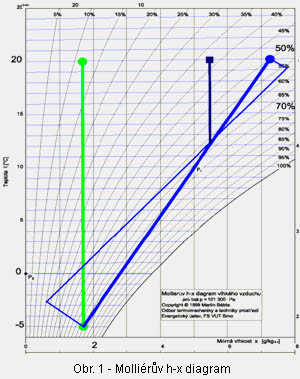 |
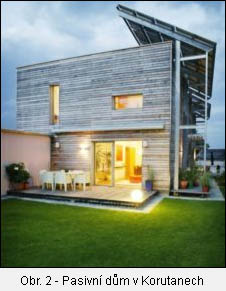 |
Isobaric ventilation units, due to hygiene requirements, bring into the building realistically 90 - 250 m³/h of ventilation air, which could be used for tempering = maximum heating power from 0.9 to 2.5 kW (assuming that the incoming air is heated to a maximum temperature of 50°C (at higher temperatures, the dust in the air breaks down into smaller particles). However, the building requires a greater heating power at lower outdoor temperatures and when it is unoccupied (lacking gains from occupants' activities). If the building has a heat loss of about 2 kW at a calculated outdoor temperature of -18°C, then at a usual winter temperature of -5°C this loss is about 1.3 kW. When using an isobaric ventilation system, it is necessary to continuously introduce 130 m³/h into the building and heat it to about 50°C. When this value is compared with the volume of the building (e.g., 400 m³), then the air exchange is at an intensity of n = 0.3. Without the presence of people, however, there is no internal moisture production. And we return to the beginning of the article - possibly low interior humidity.
Thanks to the implementation of the NED Koberovy building in 2001, a different method of controlled ventilation, which was connected with a system of circulating warm air heating, was introduced in the Czech Republic. In Figure 3, there is a functional diagram of this system. Against the isobaric ventilation system, an internal return branch is added under the label C1 (circulation). The same system is then implemented in the first energy passive houses in the Czech Republic.
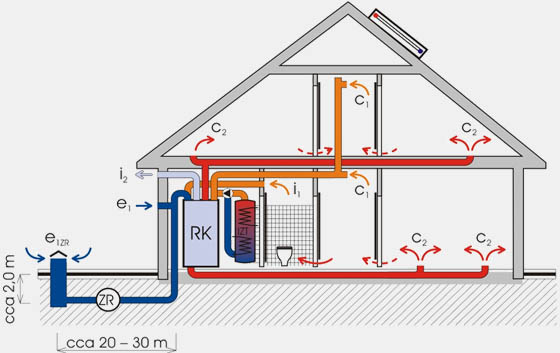 |
Fig. 3 - Diagram of warm air circulating heating with burst ventilation including waste heat recovery
LEGEND:
c2 - supply of heated and ventilated air into living rooms
i1 - extracting air from bathrooms and toilets (waste air)
i2 - exhaust - removing waste air from the building
e1 - intake of outdoor air - supply of fresh air into the building
c1 - internal air circulation loop in the building
EPD in the Conditions of Implementation in the Czech Republic
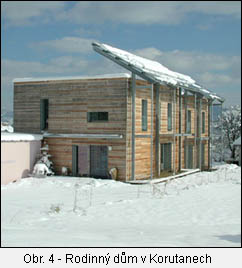 |
EPD - Relative Humidity
An important parameter of housing quality is also the internal relative humidity of the interior. The influences affecting rh were described in the introduction. Thanks to the system of circulating warm air heating, mathematically ensured controlled ventilation, and mainly due to the perfect airtightness of passive standard buildings, it is possible to ensure a suitable level of relative humidity for people. As measurements on inhabited houses have shown, even during extreme frosts in January 2006 (at night the temperature dropped to -25°C), the internal relative humidity remained within a reasonable range without any internal control sensors (based solely on a mathematical model). The graph in Figure 5 shows the measurements from such a building from 2005.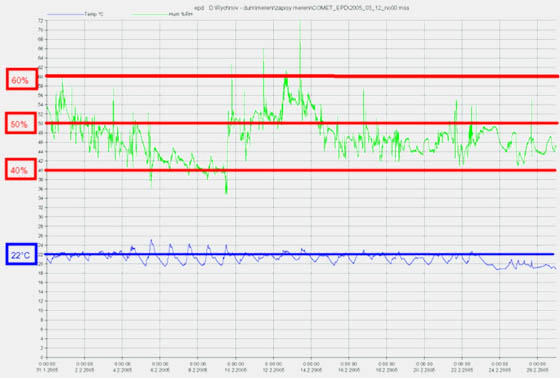 |
Fig. 5 - Graph of relative humidity measurements and interior temperature in a inhabited house equipped with a warm air circulating heating system and burst ventilation with waste heat recovery.
The excerpt is from the period of January 31 to February 27, 2005. During the period from 7 to 10, the building was empty, with no moisture production from occupants' activities - a drop followed by a subsequent increase in rh is visible.
EPD - CO2 Concentration
To achieve the desired energy consumption parameters, it is necessary to minimize infiltration to the lowest possible level. A perfect (hermetically tight with correct implementation) airtightness of the building ensures that the energy loss through infiltration is minimized, but to ensure a balanced interior climate, it is essential to supply sufficient amounts of outdoor fresh air. Of course, this must be considered with respect to the relative humidity in the interiors. Here different requirements clash - due to rh, we should ventilate "little," but to ensure an appropriate CO2 concentration as much as possible. As measurements demonstrate, with proper design, the investor need not worry. In Figure 6 there is a graph comparing CO2 concentrations - results from theoretical modeling and actual measurements in an inhabited EPD-standard building. |
Fig. 6 - Graph of CO2 concentration measurements in the interior compared to a theoretical mathematical model prepared for the EPD Rychnov building
EPD - Operating Costs (for the year 2005, projections for 2006 and subsequent years)
We reach the most important question - what do the increased acquisition costs (besides thermal comfort and the proper microclimate) bring in economic terms. It is often stated in the literature that compared to regular construction, the price of EPD objects is about 8 - 10% more expensive. In the Czech Republic, investors are often surprised that the demands of implementing companies are somewhat higher - from about 20 - 40%. Where is the problem? The value of 8-10% is taken from Austrian and German sources. However, if we compare a "regular" Austrian and a "regular" Czech house, we find that getting ours to the level of a reference foreign house would mean adding thermal insulation and installing (albeit a simple) ventilation system, often even without waste heat recovery. Only then would the starting line be compared, and it would be possible to reach the next level - the EPD standard. Therefore, there is a difference in increases in acquisition prices. Another huge problem lies in the lack of information and inexperience of Czech implementing companies. During calculations, to be sure, they "insure" themselves, resulting in skewed final prices due to this artificial intervention. However, let’s try to demonstrate the potential savings in operating costs through a specific implementation of EPD and specific measured values, which can serve as a guide for negotiations between potential clients and construction companies.Heat losses in the EPD Rychnov building (at tevyp.=-18°C) through transmission range (according to several calculations) between 1800 - 2100 W. The differing results are due to the calculation methods and rounding of parameters. The heat loss through ventilation without recovery would be 1256 W (note approx. 70% of heat loss through transmission!!), thanks to heat recovery with an average efficiency of 85% from the DUPLEX RB units used in EPD Rychnov it is then 188 W. For the following comparisons, we will use the calculation variant with the "worst result," where the overall loss through transmission and ventilation in EPD Rychnov at te = - 18°C is about 2245 W. This figure alone does not say much. The following table shows important parameters of the building related to this topic:
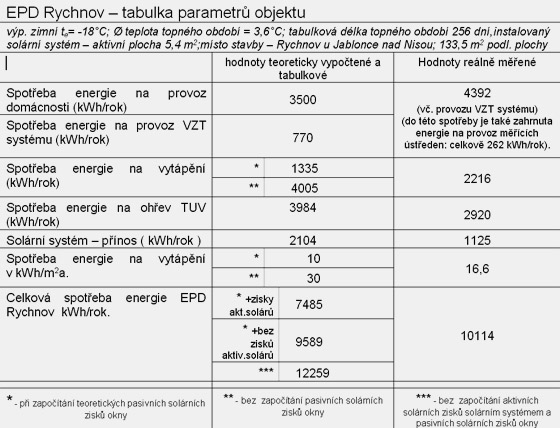 |
Let us briefly examine the individual items:
Household Operating Consumption - is generally stated to range from 3,000 to 4,500 kWh/year according to the degree of household electrification. In other measured NED object implementations, the values range from 2,900 to 3,700 kWh/year.
Energy Consumption for Heating - even in EPDs, heating is partially necessary. The table length of the heating season in Jbc is 256 days. Due to the parameters of the EPD Rychnov building, in 2005 there were 147 days when heating was needed. Just for comparison - in panel houses in Jbc heating began on September 13, 2005, in EPD Rychnov on November 3, 2005 - 51 days later. Passive solar gains also have a very significant impact on this parameter (i.e., the sun’s energy passing through the windows). In all calculations, data from long-term measurements are used. In reality, there are years when sunny days are more, and sometimes less. Therefore, for comparison purposes, theoretical values for both extremes are used - solar radiation according to tables and also a theoretical variant, if the sun did not shine the entire heating season. Smaller gains may also be caused by other, independent facts - a neighbor builds a house such that ours is partially shaded; there are trees in front of the house - deciduous trees are welcome (in summer the leaves pleasantly shade, once they fall, branches do not matter much), conifers (except for larch) shade year-round. From November 3 to December 24, 2005, there were only 2 sunny days in Rychnov. The size of the glazing on the southern facade of the house (4.3 m2) is sufficient (even though this contradicts other opinions) - on sunny days, the gains do not cause overheating of the interior (max. tint = 23.5), and during times without sunshine, they do not cause greater heat losses. (The eastern and western windows, then during winter, do not contribute to the gain balance - the sun is low on the horizon, and before it starts shining into those windows, it sets behind the forest).
If we convert energy consumption into floor area (the result is in kWh/m2a.), the influence of passive solar gains is once again clearly visible in the results. Theoretically, it ranges from 10 to 30 kWh/m2a. The resulting measured value of approximately 16.6 kWh/m2a. is, in our view, excellent - for the first season of operation, during which users were still learning to use such a comprehensive building properly.
Solar System - thanks to the implemented solar system, part of the energy is covered by the sun. As with passive gains, it is important to note that they are only usable when the sun shines. In the location of the building, and in view of the climatic conditions of 2005, these gains were about 50% against the theoretical tabulated values (there may also be a certain inaccuracy in how these gains are measured by the solar device).
Total Energy Consumption - this is the energy needed for the operation of the building (household overhead - cooking, lighting, computers…), operation of the ventilation system, heating of domestic hot water, tempering. The EPD Rychnov also had a constant load for powering all measuring centers (approximately 30 W; per year approximately 262 kWh = about 2.7% of the total energy consumption of the building!!). Therefore, be cautious of devices in standby mode - television, radios, computers + monitors - it shows!!.
Operating Costs, Payments for Electricity Consumed
The EPD Rychnov was operated from January 1, 2005, to November 1, 2005, under tariff D 25 (for 8 hours per day NT and 16 VT tariff). (NT = low tariff, allowed charging of accumulation storage for heating + domestic hot water; VT = high tariff, charging blocked). From November 1, 2005, tariff D 35 was agreed (16 hours of NT and 8 hours of VT during the day). For reference, calculations were also made from combined annual tariffs for scenarios where the building was operated all year under tariffs D25, D35, and D45 (20 hours of NT + 4 hours of VT). The D35-without-recovery column compares the window venting variant - for possible comparison of savings thanks to recovery.(All calculations are based on costs, lump sums, and payments from Severočeská energetika for the year 2005; for 2006 based on ČEZ tariffs - the successor of SČE):
 |
From the table, it is evident that for the operation of such a building, it did not matter whether tariff D 25 or D 35 was used. Tariff D 45 was economically unsuitable. It is appropriate for houses with higher heat loss - for accumulations of about 4 kW and above, for electric boilers or heaters it is necessary. It is also apparent that in 2005 prices the "economic gain" from the use of recovery is approximately 2700 CZK/year.
From January 1, 2006, the tariffs and prices for individual rates increased. The increase in the price of kWh in NT was rather drastic - for example, in tariff D 35, there was an increase of 0.47 CZK/kWh, which represents a 42% increase. See the table:
 |
 |
A comparison reveals that tariff D25 is now extremely disadvantageous even for EPD; the change in prices suggests a pressure to eliminate this rate in the near future. Although tariff D 35 experienced a 42% increase in NT cost per kWh, overall (after accounting for the decreased permanent fixed charge - note, it is 1020/year - and also due to a significant reduction in the price of VT) this represents only a 4.4% year-on-year increase. Due to the increase in energy prices, it is noteworthy to mention the "economic gain" from using recovery - it now amounts to 4564 CZK/year. And energy prices are not going to decrease, quite the opposite.
Tariff D45 appears beneficial compared to 2005 (increased by 0.41%), but it’s important to consider the absolute value - still unfavorable compared to tariff D35.
Lastly, let’s imagine that the EPD Rychnov was implemented using structures with U parameters according to ČSN 7305040-02 - recommended values (currently, one should not even consider the required values during the construction of any structures). If we theoretically compare calculations with the actual values achieved (noted - calculations), we arrive at the following numbers:
 |
The results of this last table deserve a more detailed description:
Comparing the values from 2005 reveals a difference in operating costs between theoretically considered objects with identical technical equipment of about 7,000 CZK/year. The difference in operating costs between a building without recovery with "recommended" parameters and EPD with recovery is then 9,400 CZK/year.
The comparison of values from 2006, however, is somewhat different. For equally technically equipped structures, there is a difference of about 9,800 CZK/year in operating costs. And the difference in costs between a recommended parameters house without recovery and an EPD with recovery is 14,245 CZK/year. The increased financial costs for adjustments (improving thermal insulation parameters - "U") of the building part and technical equipment of the house with forced systems with recovery return more significantly faster. And energy prices will rise - next year we might very well have 19,000 CZK instead of 14,245 CZK.
Due to the small energy requirement, the rise in operating costs for EPD is slower than for the second house. The overhead consumption (household operation) is the same for both buildings and depends only on the users and the equipment of the house (in the modeling case both houses are used by the same family). Due to the lower heating demand of EPD, passive solar gains, and also the gains from household operation play a more significant role. In a period when EPD no longer needs to "heat," for example, our model building (recommended values) requires a continuous heat input of 1 kW. This requirement is met by EPD at outdoor temperatures about 10°C lower. The shortening of the heating season to about 50-60% of tabulated values confirms this.
Conclusion
With a gable roof, EPD Rychnov visually does not differ from other buildings in the vicinity. Even in this regard, it behaves passively - inconspicuously. The trend in construction toward reducing operating costs is confirmed. Users gain the best pension insurance.To conclude, a quote from Doc. Tywoniak:
"Don't forget to enjoy a well-built house - it is above all kilowatt-hours"
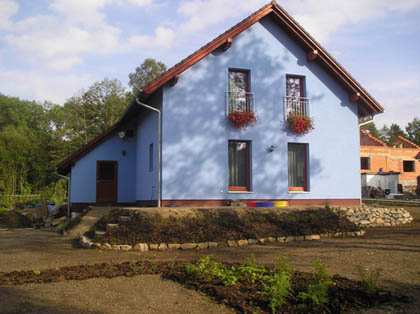 |
EPD Rychnov near Jablonec - western view
The English translation is powered by AI tool. Switch to Czech to view the original text source.
0 comments
add comment










